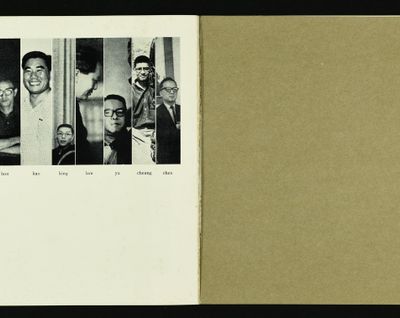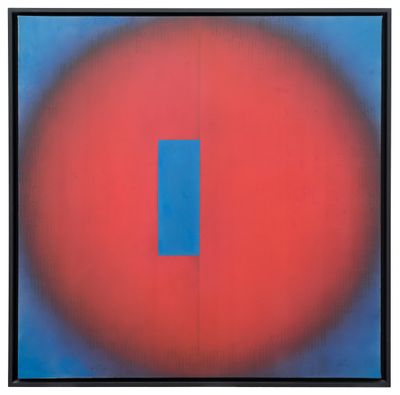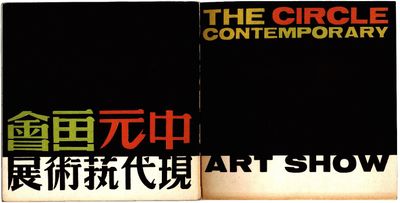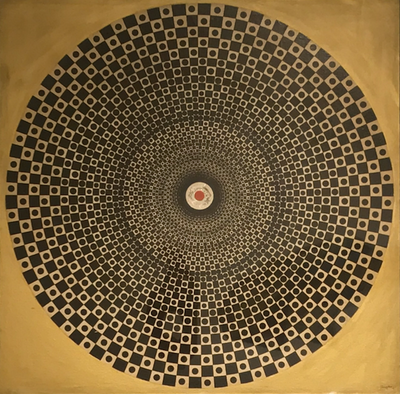In Focus: Circle Art Group

Circle Art Group 1964 exhibition catalogue membership pages. © Circle Art Group. Courtesy the Ha Bik Chuen Family, and Asia Art Archive.
Founded in 1964 and active through to 1971, the Circle Art Group was regarded as Hong Kong's 'local avant-garde'.1 Their abstract art practices were described as 'entrenched within a Chinese tradition', whilst 'fighting internal battles' between East and West, 'which produce[d] new unexpected forms and concepts.'2 Arguably, these two cardinal constructs were used as fixed anchors so that the Group's practices could be interpreted as combining and reinventing these cultures and philosophies.
By examining a number of local and international exhibitions that the Circle Art Group were part of at the time, this text considers how the Group navigated and leveraged existing mechanisms of exhibitions and relationship networks for themselves and their peers. The intention is to show, through Circle Art Group's exhibition activity, how Hong Kong's art scene was already cosmopolitan and international during the 1960s and 70s.
Who's Who
The Circle Art Group primarily included nine to eleven members during its active years: all Hong Kong-based men, some of whom are now among the city's most well-known artists, such as Hon Chi Fun (韓志勳, b. 1928, Hong Kong), Wucius Wong (王無邪, b. 1936), and Cheung Yee (張義, b. 1936, Guangdong).3
Hon, who is recognised for his silkscreen prints and abstract spray-gun paintings of circular forms, became Hong Kong's first artist to receive the Rockefeller Grant in 1969. With this support, he travelled to the USA and beyond, including Nicaragua and India.4 Wucius Wong is predominately known for his ink paintings, which elude distance and perspective through the incorporation of design elements such as grid lines. From 1968 to 1974, Wong was assistant curator at the City Hall Museum and Art Gallery, organising many exhibitions and museum acquisitions.
Cheung Yee, who now resides in Los Angeles, was a 1958 graduate of Taiwan Normal University, and was Dean of the Fine Arts Department, New Asia College, at the Chinese University of Hong Kong from 1982 to 1994. Cheung's most easily identifiable works include bronze sculptures of crab-like creatures (like the one outside the Hong Kong Space Museum), as well as bronze and paper casts that, while unmistakably resembling female genitalia, are often interpreted as Chinese bone oracles.
Other members included Van Lau (文樓, b. 1933, Guangdong), who is known locally as a bronze sculptor, with one work in the form of a renaissance man installed in the Cultural Centre foyer. King Chia-lun (金嘉倫, b. 1936, Shanghai), recognised as an educator, was director of the Chinese University of Hong Kong's extra mural studies department from 1966 to 1996. During his tenure, King ran courses that many self-taught Hong Kong artists enrolled in. Before emigrating to Canada in 1965, David Lam Chun Fai (林鎮輝, 1932–2013) was one of the most visible members of the Circle Art Group, showing in Hong Kong and Manila, and receiving commissions from the Hong Kong Tourism Board.
Jackson Yu (You Shaozeng 尤紹曾, 1911–1999), known later in life for his figurative paintings, was an abstract painter who showed in Southeast Asia. Yu was also the founder and owner of Sally Jackson Gallery, one of the key galleries in 1960s Hong Kong, located in Tsim Sha Tsui's Ocean Terminal. Sally Jackson Gallery's exhibitions showcased the Group (1966, 1967 and 1970) and its individual members separately for solo shows. It also showed the Filipino painter Jose Joya (1966), the Taiwanese abstract art group The Fifth Moon Group (1967), and Stanley William Hayter from Paris' Atelier 17 (1970).
The remaining members of the Circle Art Group were Canada-based Paul Chui Yung Sang (徐榕生, b. 1933, Hong Kong), and US-based architect Gilbert Pan Sze Chiu (潘士超, b. 1925, Hong Kong), a 1966 Rockefeller Study Fellowship recipient and Harvard graduate. Artist, collector of Chinese paintings, and military veteran who served in India, Kuo Ven Chi (郭文基, b. 1944), along with Chen Ping Yuon (陳炳元, year of birth unclear) complete the Group's roster of 11.
Circulating in Hong Kong and Overseas
The Circle Art Group showed over 40 times within and outside of Hong Kong between 1958 and 1971, with the distribution of local and international exhibitions being roughly 50/50. They regularly held an annual group exhibition at the City Hall Museum and Art Gallery, renamed the Hong Kong Museum of Art in 1975. International exhibitions included the 1961 São Paulo Biennale, where Wucius Wong was part of the Taiwanese delegation,5 and the First International Exhibition of Fine Arts in Saigon in 1962, where Wong joined the Hong Kong delegation alongside Gilbert Pan, David Lam, King Chia Lun, and Cheung Yee.6
In 1966 and 1967, the Group held exhibitions at the Luz Gallery, the most well regarded commercial gallery in Manila at the time, run by artist and institutional builder Arturo Luz (b. 1926, Manila). At the 1970 Osaka Exposition, Wong, Van Lau and Cheung Yee were included in the Hong Kong Pavilion, a structure designed by British architect Alan Fitch featuring 13 sampan sails brought up and down as part of a daily performance.7 In 1971, Cheung Yee was the sole Circle Art Group member represented in the Hong Kong delegation to the second India Triennial, also known as the India Triennale of Contemporary World Art, in New Delhi.8
It is notable that the exhibitions mentioned above all took place outside of Europe and America. This indicates the Circle Art Group was part of an exhibition circuit outside of the dominant Euro-American sites, such as Paris and New York. The host countries of some of these international exhibitions, such as Vietnam and India, were members of the Non-Aligned Movement during the Cold War period. Much like the US-capitalist and Soviet communist blocs, art and culture was deployed by Non-Aligned nations to imagine and create their versions of communities and ties of friendships.
Whether the Circle Art Group subscribed to the Non-Aligned Movement's politics was perhaps a more ambivalent matter. Indeed, a few years after the Saigon Exposition, Cheung Yee (1965), Gilbert Pan (1966), Hon Chi Fun (1969), and Wucius Wong (1970) accepted support from American foundations, such as the Rockefellers and the Institute of International Education Grants, to further their studies in the United States.
Commercial and Colonial Circuits
The sustained presence of the Circle Art Group in commercial galleries throughout Hong Kong and Manila in the 1960s and 70s challenges the general impression that artists practicing in Hong Kong at the time were commercially unsuccessful and weakly networked. Cheung Yee, for example, was first introduced to Arturo Luz through Leandro Locsin (1928–94), the prominent Filipino architect behind the Cultural Center of the Philippines. The works by Circle Art Group artists on show and for sale at the Luz Gallery were well received, and Cheung has had a solid collector base in Manila for decades.9
Some of the works by Circle Art Group and other Hong Kong artists, such as Alan Zie Yongder (施養德b. 1944, Fujian) might have even made their ways to the Ateneo Art Gallery's collection through Fernando Zóbel's bequest to the Ateneo.10 In Hong Kong, the Group created and maintained its visibility by frequently holding group and solo exhibitions in galleries such as Hong Kong's Chatham Galleries and the aforementioned Sally Jackson Gallery.
The relationship between the Circle Art Group and the British colonial government in Hong Kong is another area that needs further examination. While Wucius Wong's inclusion in the Taiwanese delegation to the 1961 São Paulo Biennale and the Hong Kong delegation to the 1962 Saigon Exposition was self-organised, the Hong Kong delegation to the 1970 Osaka Expo and 1971 India Triennale were organised by the City Hall Museum and Art Gallery, which were part of the British colonial government.
A relationship between the Circle Art Group and the British colonial government is also evident through the Group's widely reported exhibition at the City Hall Museum and Art Gallery in 1968. Not only was the show repeatedly publicised in the City Hall Museum and Art Gallery's press releases and newsletters, but an identical version of the exhibition catalogue's text was also published in the magazine What's Doing in Hong Kong.11 The eventual acquisition of works from this exhibition by the Museum and Art Gallery was publicised in another press release.12
The Circle Art Group members were also among the artists of Hong Kong Art Now (1971), an exhibition of art from Hong Kong staged in the United Kingdom and organised by the City Hall Museum and Art Gallery—the show travelled to London, Edinburgh, Manchester, and Bristol.13 All of the international exhibitions mentioned above highlight a cosmopolitanism within the Hong Kong art scene during the 1960s and 70s that may come across as surprising to audiences and readers today, since this has not yet been written into the dominant narratives of Hong Kong art history.
Circling on...
As mentioned earlier in this text, the Circle Art Group's membership throughout its years remained relatively consistent. Networks of visibility, circulation and access to support was thus arguably maintained for and by the Group but did not extend outwards.
However, it must also be noted that in 1960s Hong Kong, the city's exhibitions infrastructure was barely existent. The City Hall's low and high block galleries were not in use until 1962. Other exhibition sites such as St John's Cathedral was not purpose-built for shows, and the Hong Kong Club was an exclusive, members-only venue. In order to exhibit and gain visibility, it was up to the artists themselves to build, navigate, and leverage their own networks. Opportunities to exhibit overseas were thus enthusiastically sought out and embraced.
The terrain of exhibitions in Hong Kong increased in complexity and diversity later in the 1970s, with the establishment of the Hong Kong Arts Centre, and the staging of exhibitions by art dealers and gallerists such as Nigel Cameron and Sandra Walters. But that is another story for another time.
In the end, it is unclear how and when the Circle Art Group disbanded, but the line was said to have been drawn in 1974. One possible reason for the Group's dissolution was the overseas travels and studies that some of its members undertook, but it is also possible that the increase in exhibition spaces and opportunities in 1970s Hong Kong made it less necessary for the Group to exhibit together.
Through this brief story focusing on the Circle Art Group and its international circulation, this text positions Hong Kong's 1960s and 1970s art scene as already cosmopolitan and international, and hopes to show the possibilities of how this narrative can be further explored. —[O]
—
1 Hong Kong City Museum & Art Gallery, 'Avant-garde Exhibition will be on view at City Hall Art Gallery', press release, 1968.
2 John Warner, 'Introduction' to The Circle Art Group: Exhibition of Painting and Sculptures, City Museum and Art Gallery, Hong Kong, 1968.
3 See: Modern Literature and Art Association brochure, Xiandai wenxue meishu xiehui, 1963.
4 See: Anthony Leung Po Shan and Bernard Luk (eds), Modern Art in a Colony: Narrated by Hon Chi-fun at the Millennium, York Centre for Asian Research, York University, York, 2008, pp. 55–100; and interview with Hon Chi Fun by Shum Longtin, Hong Kong Art History Research Project, Asia Art Archive and Hong Kong Museum of Art, 2013.
5 See: interview with Liu Kuo-sung conducted by Lesley Ma, Hong Kong Art History Research Project, Asia Art Archive and Hong Kong Museum of Art, 2013; and interview with Wucius Wong conducted by Simon Chiu Kam Shing, Hong Kong Art History Research Project, Asia Art Archive and Hong Kong Museum of Art, 2013.
6 See: First International Exhibition of Fine Arts of Saigon 1962, Republic of Vietnam, Saigon, 1962.
7 Julian Kei and Daniel Cooper, '76 Countries and One Administrative Zone: Hong Kong in World Expos', unpublished research and public presentation for M+ / Design Trust Research Fellowship 2016, 4 March 2017.
8 See: Second Triennale—India 1971, Lalit Kala Akademi, New Delhi, 1971.
9 See: interview with Cheung Yee by Vivian Poon, Hong Kong Art History Research Project, Asia Art Archive and Hong Kong Museum of Art, 2015. Individuals from Circle Art Group who held solo exhibitions at the Luz Gallery during the 1960s-70s included David Lam, Jackson Yu, Cheung Yee, Wuicus Wong, and Van Lau.
10 The author was able to see works by Cheung Yee and Alan Zie Yonder in the Ateneo Art Gallery during an earlier research visit to Manila in October 2015.
11 What's Doing in Hong Kong, 1968, pp. 3-10.
12 Hong Kong City Museum & Art Gallery, 'Avant-garde Art Work Purchased for the City Hall Art Gallery', press release, 1968
13 Art Now・Hong Kong, exhibition catalogue, City Hall Museum and Art Gallery, Hong Kong, 1971.
—
This text was developed from materials collected through the author's ongoing research on shared exhibition histories of Hong Kong artists in Manila, as well as Hong Kong's exhibition histories at large. Much of this research has been made possible by the research programme 'Ambitious Alignments: New Histories of Southeast Asian Art', led by Power Institute, University of Sydney, and National Gallery Singapore, and is funded through the Getty Foundation's Connecting Art Histories initiative. The sharing of materials from the personal archive of late Hong Kong-based artist Ha Bik Chuen by his family, materials shared by the Hong Kong Museum of Art, as well as the research conducted by 2016 M+ Design Trust Research Fellows Julian Kei and Daniel Cooper have also played an instrumental role in the mapping of a significant amount of resources in this research.
Michelle Wong is Researcher at Asia Art Archive.
















































































































































































